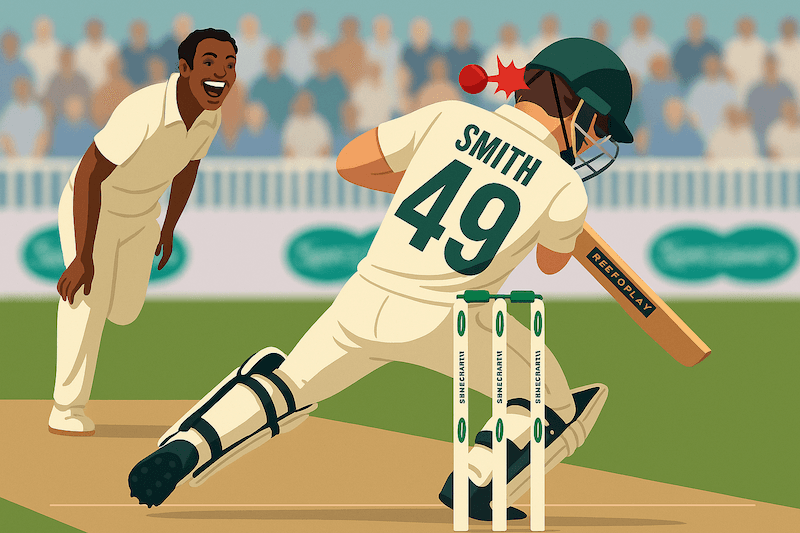
In cricket, a batter remains at the crease until they are dismissed. The Laws of Cricket officially recognize 10 methods of dismissal, though some are far more common than others. Each one has its own story and adds to the drama of the game. Here is a complete guide for anyone new to cricket.
Bowled
- A batter is bowled if the ball delivered by the bowler hits the stumps and dislodges the bails.
- This can happen whether or not the ball touched the bat, pad, or any other part of the batter.
- It is one of the clearest and most satisfying dismissals for a bowler, showing pure dominance.
Caught
- A batter is out caught if the ball hits the bat or glove (while holding the bat) and is taken by a fielder before it touches the ground.
- The catch can be taken by any fielder, including the bowler or wicketkeeper.
- When the wicketkeeper takes the catch from an edge or glove, it is commonly called “caught behind,” one of the most frequent and celebrated dismissals in cricket.
- This is the most common way of dismissal and rewards both sharp reflexes and safe hands.
Leg Before Wicket (LBW)
- A batter can be out LBW if the ball hits their body, usually the pads, and the umpire judges that it would have gone on to hit the stumps.
- For LBW to apply, the ball cannot pitch outside the leg stump, and it must not have made contact with the bat first.
- There are detailed conditions, but in simple terms, LBW stops batters from using their legs as a second set of stumps.
- The LBW law ensures batters use the bat to defend the stumps rather than their legs.
Explore More Stories

2005 Ashes: The Summer Cricket Became Theatre
The 2005 Ashes was more than just a cricket series. It was a rollercoaster of emotion, courage, and unforgettable moments that brought Test cricket back to life. England’s long wait finally ended, and the world watched history unfold.

What Happened to Zimbabwe Cricket? The Rise, Fall, and Fight for Survival
Once they challenged the world’s best, now they struggle to stay afloat. Zimbabwe cricket’s journey from the glory of 1999 to years of chaos and heartbreak is a story of politics, power, and lost pride, and of a nation still dreaming of revival.
Run Out
- A batter is run out if a fielder breaks the stumps with the ball while the batter is outside the crease attempting a run.
- This usually happens through a direct hit or a quick throw from the fielders.
- It is often the result of hesitation or miscommunication between batters, making it one of the most dramatic dismissals.
- Run Out at the Non-Striker’s End (Mankad): If the non-striker leaves the crease before the ball is delivered, the bowler is allowed to break the stumps and appeal for a run out. This method is legal under the Laws of Cricket, though it has been debated for its spirit of play.
Stumped
- A batter is stumped if the wicketkeeper removes the bails while the batter is out of their crease and not attempting a run.
- This dismissal usually occurs when the batter comes down the pitch to play a big shot against a spinner and misses the ball.
- It highlights the quick thinking and sharp hands of the wicketkeeper.
Hit Wicket
- A batter is out hit wicket if they accidentally dislodge the stumps with their bat, body, or clothing after the bowler has entered the delivery stride.
- It often happens when a batter steps too far back or loses balance while playing a shot.
- Though rare, it is a reminder of cricket’s fine margins where even a small mistake can cost a wicket.
Obstructing the Field
- A batter is out obstructing the field if they deliberately block a fielder or interfere with the ball in play.
- This includes actions like using the hand to stop the ball without the fielding side’s permission, which was once recorded separately as “handled the ball.”
- It is one of the least common dismissals, only applied when the act is clearly intentional.
Timed Out
- A batter can be dismissed timed out if they take too long to be ready at the crease after the previous wicket has fallen.
- Under the official Laws of Cricket (Law 40), the time limit is 3 minutes for the incoming batter to be ready.
- However, the ICC’s playing conditions for international matches are stricter: 2 minutes in Tests and ODIs, and just 90 seconds in T20 internationals.
- This difference has caused confusion at times. For example, during the 2023 Cricket World Cup, Sri Lanka’s Angelo Mathews became the first player ever dismissed timed out in international cricket — he was within the 3-minute Law but exceeded the 2-minute ICC limit.
- Though extremely rare, this dismissal exists to keep the game moving quickly.
Hit the Ball Twice
- A batter is dismissed if they intentionally strike the ball a second time, other than for the sole purpose of protecting the stumps.
- For example, if the ball deflects off the bat and rolls toward the stumps, the batter is allowed to stop it, but not to hit it again in order to score runs.
- Priority of other dismissals applies here: if the second strike prevents a fielder from making a catch, the batter would be given out for obstructing the field, not for hit the ball twice.
- This dismissal is extremely rare and highlights cricket’s layered and precise rules.
Retired Out
- A batter who leaves the field voluntarily without injury and chooses not to return is recorded as “retired out.”
- Unlike “retired hurt,” which allows a batter to resume their innings later, “retired out” counts as a dismissal.
- Extremely rare in Tests and ODIs, but sometimes used in modern T20s as a tactic to bring in a more aggressive batter for the final overs.
The Last Wicket
From the familiar bowled and caught to the almost mythical timed out or hit the ball twice, cricket’s dismissals capture both its precision and its quirks. Some, like the Mankad, spark endless debate, while others, like LBW or run out, shape the tactics of every match. Together they remind us that in cricket, every ball carries the chance of drama — and once you understand how a batter can be dismissed, you begin to understand the heartbeat of the game itself.





